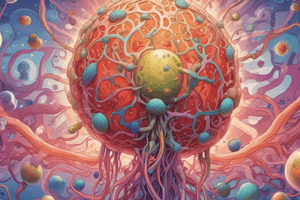Podcast
Questions and Answers
Which microorganism is responsible for causing malaria?
Which microorganism is responsible for causing malaria?
- Plasmodium (correct)
- Escherichia coli
- Penicillium
- HIV
Which of the following is an example of a harmful bacterium?
Which of the following is an example of a harmful bacterium?
- Streptococcus (correct)
- Penicillium
- Giardia
- Aspergillus
What type of microorganism is responsible for causing food poisoning?
What type of microorganism is responsible for causing food poisoning?
- Candida
- Escherichia coli (correct)
- Aspergillus
- Giardia
Which microorganism is associated with causing yeast infections?
Which microorganism is associated with causing yeast infections?
Which of the following is NOT listed as a strategy to combat the spread of disease-causing microorganisms?
Which of the following is NOT listed as a strategy to combat the spread of disease-causing microorganisms?
What is one significant concern related to the activities of undesirable microorganisms?
What is one significant concern related to the activities of undesirable microorganisms?
What is a key factor contributing to the emergence of drug-resistant microorganisms?
What is a key factor contributing to the emergence of drug-resistant microorganisms?
Which of the following is an example of an antimicrobial medication?
Which of the following is an example of an antimicrobial medication?
What is one of the most effective measures to offer protection against specific diseases, according to the text?
What is one of the most effective measures to offer protection against specific diseases, according to the text?
What is a significant focus of public health measures in combating the spread of disease-causing microorganisms?
What is a significant focus of public health measures in combating the spread of disease-causing microorganisms?
Flashcards are hidden until you start studying
Study Notes
Microorganisms: Friends and Foes - Focus on Harmful Microorganisms
Microorganisms, encompassing bacteria, fungi, protozoa, and viruses, are a diverse group of creatures that inhabit Earth's every corner, playing vital roles in maintaining ecological balance, cycling nutrients, and serving as the basis of the food chain. However, not all microorganisms are friends. Some of these microscopic life forms can be downright villainous, causing harm to humans, animals, and the environment.
Harmful Microorganisms: A Dangerous Classification
A wide range of microorganisms are classified as pathogens, capable of causing diseases or infections. They include:
- Bacteria: Common examples include Streptococcus (strep throat), Escherichia coli (E. coli), Salmonella (food poisoning), and Mycobacterium tuberculosis (TB).
- Fungi: These include Candida (thrush and yeast infections), Aspergillus (opportunistic infections), and Cryptococcus (a fungal disease that affects the lungs and central nervous system).
- Protozoa: Examples include Plasmodium (malaria), Giardia (diarrhea), and Toxoplasma gondii (toxoplasmosis).
- Viruses: Examples include HIV, influenza, and the common cold.
The Astonishing Impact of Harmful Microorganisms
Microorganisms have a profound impact on human health, causing millions of infections and deaths each year. According to the World Health Organization (WHO), around 1.7 million deaths occur annually due to antimicrobial resistance, while diseases like malaria cause hundreds of thousands of deaths annually.
Environmental harm is also a significant concern due to the activities of undesirable microorganisms. For example, some bacteria release toxic compounds (biotoxins) that can poison water and soil, while others cause the degradation of natural resources.
The Battle Against Harmful Microorganisms
Efforts to combat the spread of disease-causing microorganisms involve a variety of strategies, including:
-
Vaccination: One of the most effective measures, vaccines offer protection against specific diseases, such as measles, polio, and influenza.
-
Antimicrobial medications: These medicines, which include antibiotics, antivirals, and antifungals, fight against the growth and activity of pathogenic microorganisms.
-
Public health measures: These include water sanitation, waste management, and awareness campaigns that educate people about the importance of hygiene and the need to avoid the spread of infections.
-
Innovation: Scientists are constantly researching and developing new treatments for microbial infections, seeking to better understand the mechanisms of disease and to create more effective and targeted therapies.
The Threat of Antimicrobial Resistance
The emergence of drug-resistant microorganisms is a growing problem, making it increasingly difficult to treat and control bacterial, fungal, and viral infections. Antimicrobial resistance occurs due to several factors, including the overuse and misuse of antibiotics, the spread of resistance genes, and the evolution of microorganisms.
To combat this threat, efforts are being made to promote better antibiotic stewardship and to develop new drugs with novel mechanisms of action.
Conclusion
Harmful microorganisms represent a significant threat to human health and the environment, causing millions of deaths and infections each year. However, our understanding of these tiny creatures is rapidly evolving, allowing us to develop more effective strategies for preventing and combating microbial infections.
In summary, microorganisms are both friends and foes, playing vital roles in maintaining the balance of life on Earth. By staying informed about the issues and research surrounding these fascinating creatures, we can better protect ourselves and the world in which we live.
Studying That Suits You
Use AI to generate personalized quizzes and flashcards to suit your learning preferences.




